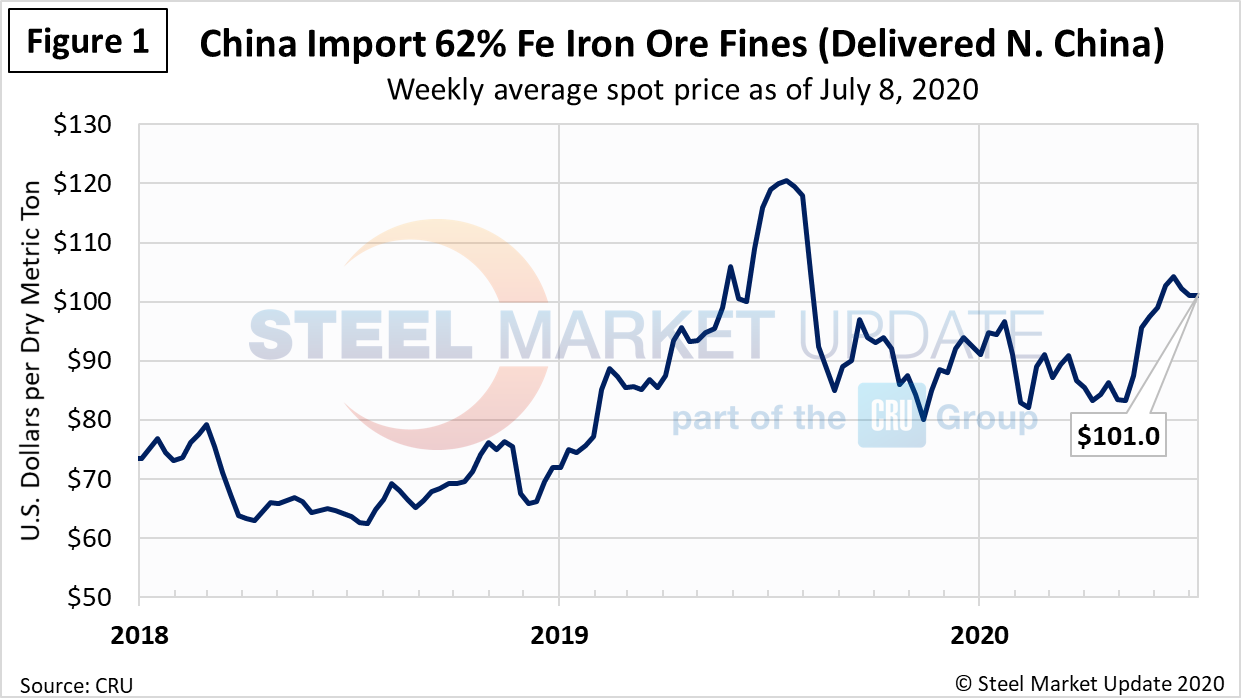Prices

July 14, 2020
Raw Materials Prices: Iron Ore, Coking Coal, Pig Iron, Scrap, Zinc
Written by Brett Linton
Strong demand in China and easing of coronavirus restrictions in various parts of the world are lending support to global raw materials prices. Ferrous scrap prices are the notable exception as supplies have increased at a greater rate then demand, sending prices for both prime and obsolete grades downward.
Table 1 summarizes the price changes through July 14 of the five materials considered in this analysis. It reports the month/month, three months/three months and year/year changes on a percentage basis.

Iron Ore
The Chinese import price of 62% Fe content iron ore fines bounced between $82-$97 per dry metric ton in the first quarter, reaching a 10-month high in mid-June at $104.3. Figure 1 shows the price of 62% Fe delivered North China since January 2018, currently at $101.0.

Coking Coal
The price of premium low volatile coking coal FOB east coast of Australia declined from late-March through early-May, currently at $113.3 dollars per dry metric ton as of July 1 (Figure 2). The seaborne coking coal price has not been able to fully benefit from the strong demand in China due to import restrictions. Recent coking coal prices remain at their lowest levels seen in SMU’s limited history.

Pig Iron
Most of the pig iron imported to the U.S. currently comes from Russia, Ukraine and Brazil. This report summarizes prices out of Brazil and averages the FOB value from the north and south ports. The latest data through July 8 shows an average pig iron price of $313 per metric ton, up from $275 in May and $295 in June, but down from $325 in February and March. Pig iron prices have declined erratically since hitting a peak of $400 per ton in June 2018 (Figure 3).

Scrap
Hot rolled steel prices fluctuate up and down with the price the mills must pay for their raw materials. Changes in the relationship between scrap and iron ore prices offer insights into the competitiveness of integrated mills, whose primary feedstock is iron ore, versus the minimills, whose primary feedstock is scrap. Prices for prime/busheling scrap have begun to decline in recent weeks, as have prices for obsolete/shredded. Scrap prices have weakened as supplies increased due to greater scrap collection and auto plant restarts as coronavirus restrictions eased. Figure 4 shows the spread between shredded and busheling, both priced in dollars per gross ton in the Great Lakes region.

Figure 5 shows the recent spread between the price of iron ore, at $101 per dry metric ton, and shredded scrap at $240 per gross ton. Ore had moved higher in recent weeks, lending some support to finished steel prices.

To compare the two, Steel Market Update divides the shredded scrap price by the iron ore price to calculate a ratio (Figure 6). A high ratio favors the integrated/BF producers, a lower ratio favors the minimill/EAF producers. As the 2.38 ratio shows, the recent increases in the price of ore, in contrast to the decreases in the increases in the price of scrap, have added slightly to the minimills’ competitive cost advantage.

Figure 7 shows how the price of hot rolled steel generally tracks with the price of shredded scrap. The two prices had diverged when we last published a raw material update in June, but have both since declined. Shred fell by approximately $18 from June to July, while hot rolled prices fell $25-40 per ton over that same period.

Zinc
Zinc, used to make galvanized and other products, declined in price for much of the first quarter, rebounded a bit in the second quarter, and has since jumped to a five-month high (Figure 8). The LME cash price per pound of zinc as of July 13 was $1.0024, up over the mid-March low of $0.8239 but still down considerably from the mid-January peak of $1.1186. The price of zinc factors into the coating extras charged by the mills for galvanized products. Many mills had recently revised their coating extras downward, effective in July, to reflect the lower zinc price. Aluminum prices, which factor into the price of Galvalume, had been relatively flat in June but jumped on Monday of this week. Aluminum prices often have large swings and return to typical levels within a few days. The LME cash price per pound of aluminum was $1.0080 as of July 13.







